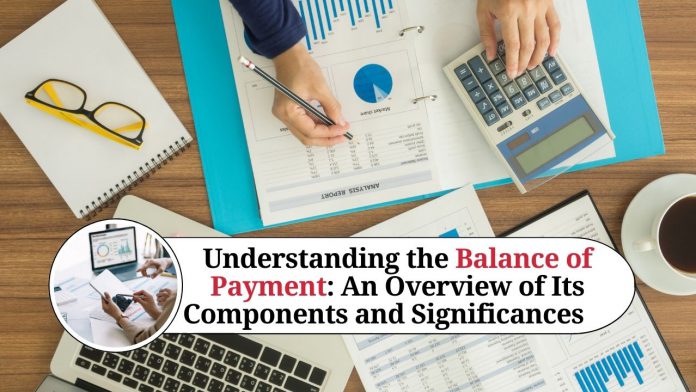Every nation participates in international trade to some extent, and this leads to the movement of goods, services, and capital across borders. As a result, a country’s balance of payment (BOP) is a vital indicator of its economic health, as it tracks all economic transactions between its residents and the rest of the world. This article aims to provide a comprehensive understanding of the balance of payment, including its components, the importance of a positive balance, and how governments can influence it.
Components of the Balance of Payment
The balance of payment comprises three major components: the current account, the capital account, and the financial account.
- Current Account: The current account tracks all transactions related to the trade of goods and services. It includes imports and exports of goods, services, and income. The current account is further divided into four sub-accounts:
- Merchandise Trade: The difference between the value of exports and imports of physical goods.
- Services Trade: The difference between the value of exports and imports of non-physical goods, such as tourism, transportation, and intellectual property.
- Primary Income: The difference between the income received by residents from foreign investments and the income paid to foreigners for their investments in the country.
- Secondary Income: The transfer of money from one country to another, such as remittances from foreign workers.
- Capital Account: The capital account tracks the transfer of non-financial assets between countries, such as patents, copyrights, and trademarks. It also includes debt forgiveness, non-life insurance claims, and non-monetary gold transactions.
- Financial Account: The financial account tracks the flow of capital between countries, including foreign investment, foreign aid, and official reserves. It includes three sub-accounts:
- Direct Investment: The purchase of a controlling stake in a foreign company.
- Portfolio Investment: The purchase of securities, such as stocks and bonds, in a foreign country.
- Other Investment: All other financial transactions, such as loans, deposits, and trade credits.
Significance of a Positive Balance of Payment
A positive balance of payment occurs when a country earns more from its exports than it spends on its imports. A positive balance of payment has several benefits for a country, such as:
- Currency Stability: A positive balance of payment helps stabilize a country’s currency by increasing its demand, which results in a higher exchange rate.
- Economic Growth: A positive balance of payment contributes to a country’s economic growth by providing it with more resources to invest in its economy.
- Reduced Debt: A positive balance of payment helps reduce a country’s debt by allowing it to pay off its foreign debt with its surplus earnings.
How Governments Can Influence the Balance of Payment
Governments can influence the balance of payment in several ways, such as:
- Trade Policies: Governments can implement trade policies to increase exports and reduce imports, such as import tariffs, export subsidies, and quotas.
- Exchange Rate Policies: Governments can influence the exchange rate of their currency to make their exports cheaper and imports more expensive. This can be achieved through devaluation or revaluation of the currency.
- Capital Controls: Governments can impose capital controls to restrict the flow of capital out of their country, which can help reduce imports and increase exports.
Conclusion
The balance of payment is a crucial economic indicator that tracks all economic transactions between a country and the rest of the world.
Other Related Blogs: Section 201 of the Income Tax Act
Understanding the components of the balance of payment, the significance of a positive balance, and how governments can influence it is essential for policymakers and individuals alike. A positive balance of payment can have several benefits for a country, including currency stability, economic growth, and reduced debt.
Frequently Asked Questions
Q.1) What is the balance of payment?
The balance of payment is an economic indicator that tracks all economic transactions between a country and the rest of the world.
Q.2) What are the components of the balance of payment?
The balance of payment comprises three major components: the current account, the capital account, and the financial account.
Q.3) What is the current account?
The current account tracks all transactions related to the trade of goods and services. It includes imports and exports of goods, services, and income.
Q.4) What is the capital account?
The capital account tracks the transfer of non-financial assets between countries, such as patents, copyrights, and trademarks. It also includes debt forgiveness, non-life insurance claims, and non-monetary gold transactions.
Q.5) What is the financial account?
The financial account tracks the flow of capital between countries, including foreign investment, foreign aid, and official reserves.
Q.6) What is a positive balance of payment?
A positive balance of payment occurs when a country earns more from its exports than it spends on its imports.
Q.7) What are the benefits of a positive balance of payment?
A positive balance of payment has several benefits for a country, such as currency stability, economic growth, and reduced debt.
Q.8) How can governments influence the balance of payment?
Governments can influence the balance of payment in several ways, such as by implementing trade policies, exchange rate policies, and capital controls.
Q.9) Why is the balance of payment important?
The balance of payment is important because it provides insight into a country’s economic health, including its trade patterns, capital flows, and debt levels. It can also help policymakers and individuals make informed decisions about economic policies and investments.




















